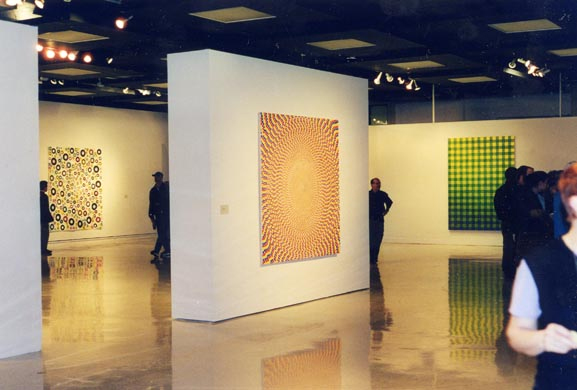
April 1999, pg 120
by James Yood
UNIVERSITY GALLERIES OF ILLINOIS STATE UNIVERSITY NORMAL, ILLINOIS

(Left to right: Tom Moody, Mark Dagley, Peter Schuyff)
All paintings
are created optically, but some are more optical than others. In
"post-hypnotic," organized by Barry Blinderman, the works of
twenty-eight contemporary painters put the human retina on trial, reminding us
that what we see depends on how we see, and that other realms of vision can
open out from the unstable act of seeing. Visual slippages, dizzying
afterimages, pulsating surfaces, and eye-popping patterns (which lead on
occasion to a vertigo-induced nausea) abound here. This is an exhibition that
asks, What happens when the viewer loses control of the picture plane?
Looking back as
far as the mid-'80s - the era in which Blinderman made a name for himself as a
New York gallerist - with works by Ross Bleckner, Peter Halley, Jim Isermann,
Walter Robinson, Peter Schuyff, and Philip Taaffe, he begins to make a case
that differentiates the dynamic visual effects of recent painting from those of
'60s Op. While echoes of Yaacov Agam, Richard Anuszkiewicz, Bridget Riley, and
Victor Vasarely linger (as do hints of latterday retro-psychedelia),
Blinderman's premise that the visual conjurations of current artists don't just
sit on the surface of the painting, they transgress the frame and move right
into the viewer's space - a realm profoundly complicated in recent years by
spectacular advances in computer graphics and digital special effects, by IMAX
virtuality and Magic Eye conundrums - is pretty convincing. Op art's formal
precision and sober two-dimensionality is the jumping-off point for works that
range from playful to composed, insouciant to jarring, from campily distant to
feverishly immediate. The dislocations integral to these works exist not at the
level of the object but at its intersection with the psychophysiology of
vision. Extending and intensifying Op art and pattern-painting strategies,
"post-hypnotic" procedures ape new visual technologies, increase
pictorial velocity, and cunningly exploit the limits of human sight.
For many of the
artists, an obsessive commitment to repetitive, miniature linear pattern
creates the visual waffling they desire. In Susie Rosmarin's exhausting (and
strangely exhilarating) Static Study #45, 1998 - made by an endlessly repeated
process of taping and painting, taping and painting, to create hundreds of
"clean" lines - the combination of the painting's large scale, its
minute detail, and unavoidable minor errors (despite the overarching regularity
of her procedure) makes her tight grid buckle and wobble, slightly, almost
imperceptibly, at first, then more intensively, as the eye grapples for an
order that remains elusive. The irreconcilable dichotomy of the hand-wrought
and the purely geometrical animates her work. Fred Tomaselli's Thirteen
Thousand, 1992 (its 13,000 individual aspirin tablets stacked in some fifty
vertical rows and sealed in resin), might be seen as an incredible variation on
classic color-field stripes. It shares a certain coy yet manic quality, a cool,
distanced stubbornness that characterizes the abstraction of so many of these
artists. Mark Dagley's Concentric Sequence #1, 1996, a
target-like image of thousands of circles of colored dots that decrease in
scale as they approach the picture's center, delivers on Blinderman's
distinction between Op art proper and the more recent work on view here:
Dagley's painting is less pointillist than pixelist. As you negotiate your way
through a Dagley or Rosmarin maze, everything seems to radiate, and your
vision, as if under the influence of hypnosis or hallucinogens, fails to digest
all it takes in, even as your brain processes pictorial information you know
doesn't exist.
Painterly works
that deploy their effects on a more material, physical level support
Blinderman's argument less directly, but still prove tantalizing. Karin Davie's
Wanted, 1998, suggests a striped color-field abstraction turned to taffy, then
pulled and refolded into meandering waves of paint - oily eddies whose viscous
coursing exerts a soporific effect. Judy Ledgerwood's In The Groove,1996, a
summery saturation of lemon yellows with pale lavender undertones, begins to
shimmer the moment you lay eyes on it, ghost images altering one's perception
of the painting's color and composition: Indeed, the viewer becomes a kind of
privileged if unwitting accomplice to the work's hallucination.
"Post-hypnotic"
invites the conclusion that the viewer's mind is as viable a surface on which
to work as the canvas itself. While no work of art can be considered
independently of the activity of looking, here the biological, chemical, and
psychological mechanisms of sight present a new locus for the manipulation of
visual order. These paintings, which exploit inevitable visual missteps, afford
the potential for a subversion that strikes at the heart of what it means to
see and to know.
James Yood
writes regularly for Artforum.
"Post-hypnotic"
travels to the McKinney Avenue Contemporary, Dallas, June 12-July 25; the
Contemporary Arts Center, Cincinnati, Sept. 4-Nov. 7; the Atlanta College of
Art Gallery, Jan. 28-Mar. 12, 2000; the Chicago Cultural Center, Apr. 22-June
25, 2000; the Tweed Museum, University of Minnesota, Duluth, Feb. 6-Apr. 2001.